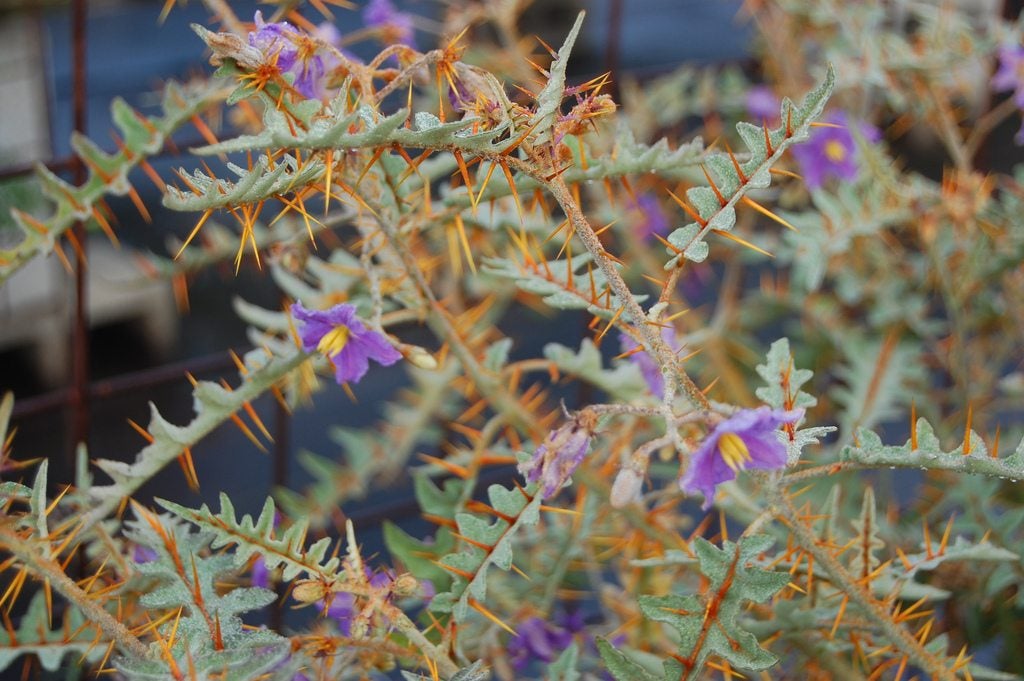What Is Solanum Pyracanthum: Porcupine Tomato Plant Care And Info


Here's a plant that's sure to attract attention. The names porcupine tomato and devil's thorn are apt descriptions of this unusual tropical plant. Find out more about porcupine tomato plants in this article.
What is Solanum pyracanthum?
Solanum pyracanthum is the botanical name for porcupine tomato or devil's thorn. Solanum is the genus of the tomato family, and this plant bears many discrete resemblances to tomatoes. A Madagascar native, it was introduced to the U.S., but has not shown itself to be invasive. This is because the plant is very slow to reproduce and birds avoid the berries, so the seeds don't get distributed. While most people consider a plant's thorns a drawback, the thorns on a porcupine tomato are a delight - at least as far as looks go. The fuzzy gray leaves give way to the bright, red-orange thorns. These grow straight up on the top sides of the leaves. Along with the colorful thorns, count on the lavender flowers to add interest to a devil's thorn plant. The flowers are shaped much like other members of the Solanum family and have yellow centers. The back of each petal has a white stripe that runs from the tip to the base. CAUTION: The leaves, flowers and fruit of the plant are poisonous. Like many members of the Solanum genus, devil's thorn contains highly toxic tropane alkaloids.
How to Grow Solanum Porcupine Tomato
Growing a porcupine tomato is easy, but it is a tropical plant and needs the warm temperatures found in U.S. Department of Agriculture plant hardiness zones 9 through 11. Porcupine tomato needs a location with full sun or partial shade and well-drained soil. Prepare the soil by working in lots of compost before planting. Space the plants so that they'll have plenty of room to grow. A mature plant measures about 3 feet (91 cm.) tall and 3 feet (91 cm.) wide. You can also grow porcupine tomatoes in containers. They look great in decorative ceramic pots and urns. The container should hold at least 5 gallons (18.9 L.) of potting soil, and the soil should have a high organic content.
Porcupine Tomato Plant Care
Water porcupine plants often enough to keep the soil moist. The best way to do this is to water the plants slowly so that the water sinks deep into the soil. Stop when it begins to run off. Water potted plants until the water runs from the holes in the bottom of the pot. Don't water again until the soil is dry at a depth of about two inches (5 cm.). Fertilize plants grown in the ground with a slow-released fertilizer or a 2-inch (5 cm.) layer of compost in spring. Use a liquid fertilizer designed for flowering houseplants throughout spring and summer for plants grown in containers. Follow the package directions.
Gardening tips, videos, info and more delivered right to your inbox!
Sign up for the Gardening Know How newsletter today and receive a free copy of our e-book "How to Grow Delicious Tomatoes".

Jackie Carroll has written over 500 articles for Gardening Know How on a wide range of topics.
-
 Grow ‘Karl Rosenfield’ Peony Plants For The Ultimate Frilly Border Beauties And Cut Flowers
Grow ‘Karl Rosenfield’ Peony Plants For The Ultimate Frilly Border Beauties And Cut FlowersFor frilly double magenta peony petals infused with a heady fragrance, grow ‘Karl Rosenfield’ peony plants. Here’s how to cultivate the ultimate plushy blooms
By Tonya Barnett
-
 10 Common Composting Problems That Can Spoil Your Garden Gold – Plus Easy Fixes
10 Common Composting Problems That Can Spoil Your Garden Gold – Plus Easy FixesLearn how to troubleshoot common composting issues before they ruin your stash – from bad smells and bugs to materials not breaking down as they should.
By Susan Albert